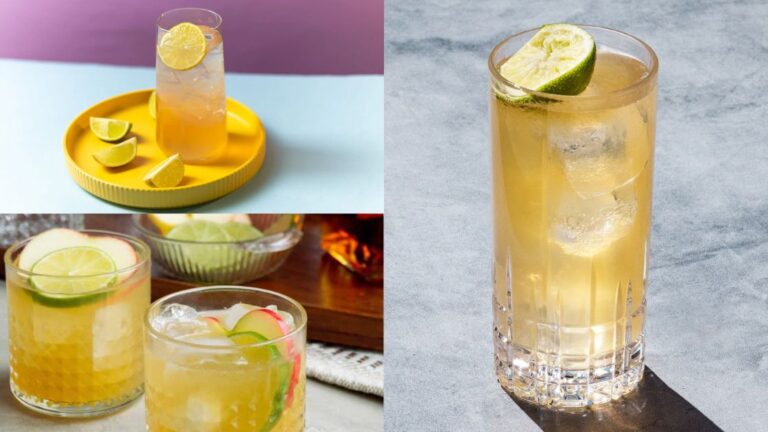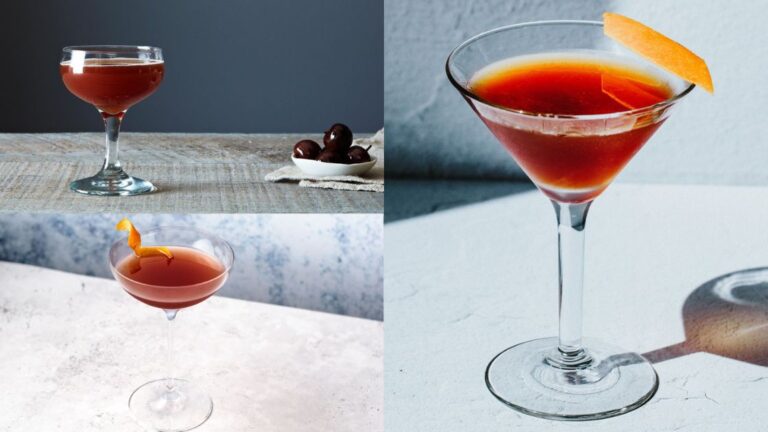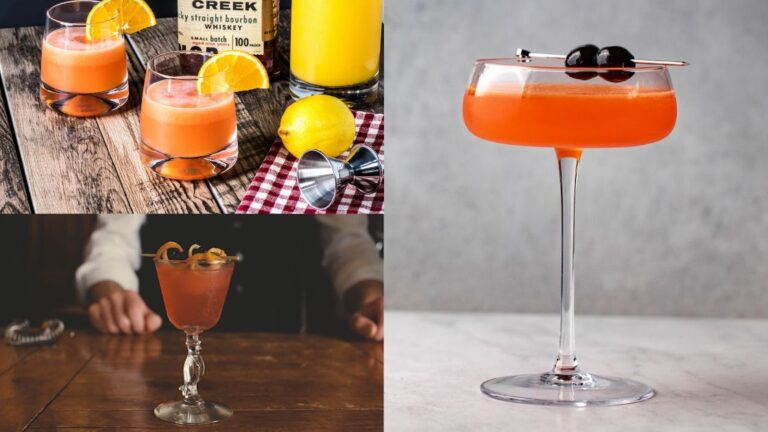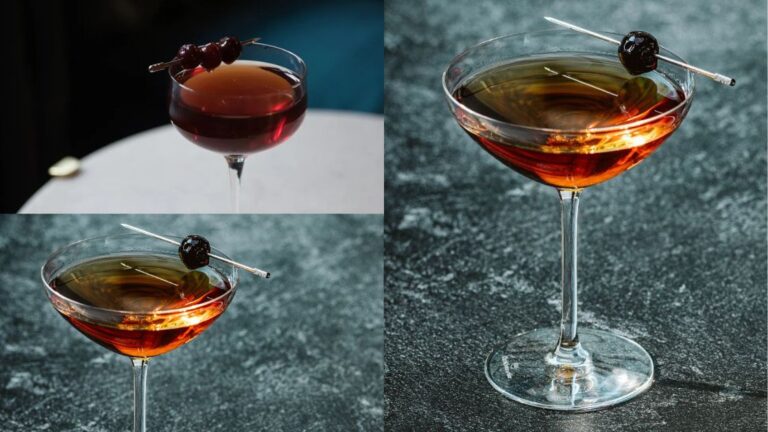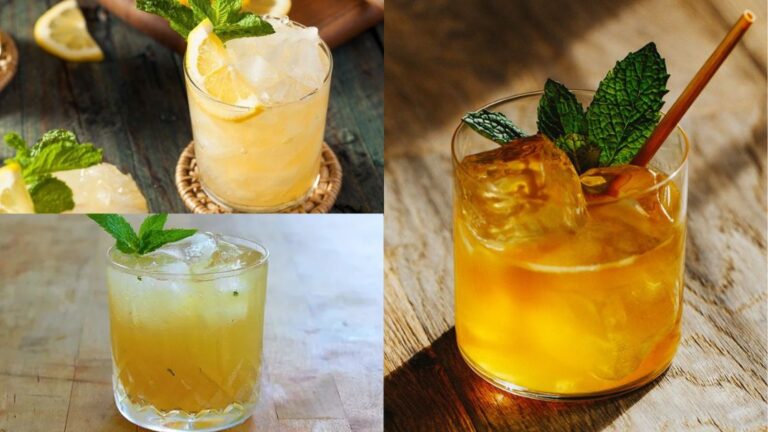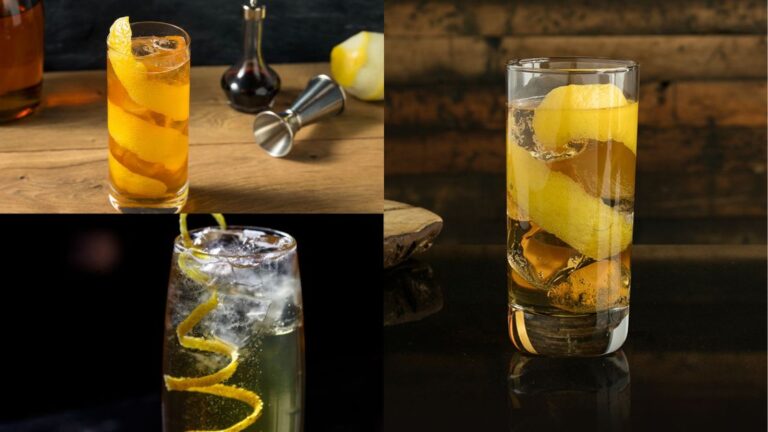Understanding Bourbon vs. Whiskey
Getting into whiskey’s universe? Oh boy, you’re in for a treat! But what’s the deal with bourbon and why isn’t it just another whiskey? Let’s break it down.
Differentiating Bourbon and Whiskey
Bourbon and whiskey are like cousins who attend the same family reunion but bring their own weird potato salad. The key difference here is the ingredients. Bourbon needs at least 51% corn in its mix, giving it a sweet little kick (Food & Wine).
| Type | Main Ingredient | Aging Process | Origin |
|---|---|---|---|
| Bourbon | At least 51% corn | Brand new charred oak barrels | Mainly U.S. |
| Whiskey | Mix it up (barley, rye, etc.) | Choices vary, aging barrels often reused | All over the map |
Bourbon snuggles up in fresh charred oak barrels, while other whiskies are less picky with their aging crib, often re-purposing older barrels (Food & Wine). Bourbon comes out of the still no higher than 80% alcohol and sticks to some strict proof rules (Clawhammer Supply).
While you can make bourbon just about anywhere in the U.S., call it “Kentucky bourbon,” only if you whip it up in Kentucky (Food & Wine). Wanna know more about the variety of whiskeys? Dive into our guide for the full scoop.
Origins of Bourbon
Maybe you heard bourbon was christened after Bourbon County, Kentucky? Curveball! It probably took its name from northeastern Kentucky’s neck of the woods. American culture and history throw their two cents into bourbon’s storied past, giving it some serious street cred.
| Bourbon Feature | Description |
|---|---|
| Primary Ingredient | At least 51% corn |
| Distillation | Max 80% booze in there |
| Aging | New charred oak only, please |
| Geographic Rule | Anywhere in the U.S.; “Kentucky bourbon” not without Kentucky roots |
Knowing these nuggets helps explain why bourbon proudly sports its crown in the cocktail kingdom. Wanna up your whiskey game? Check out our take on single malt whiskey and its fascinating past.
The trip from cornfield to your glass isn’t just tossing some stuff in a barrel. It’s carefully following a rulebook made for kings. If you’re curious about top whiskey choices, swing by and see our chart-toppers of best whiskey brands. Here’s raising a glass to your savvy new perspective!
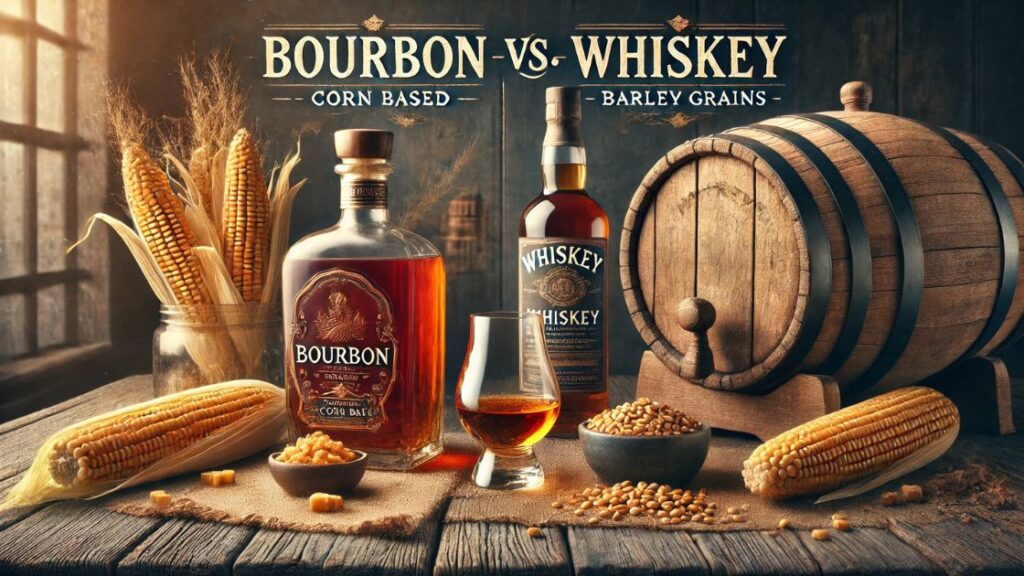
Key Characteristics of Bourbon
So you’re curious about what makes bourbon tick, huh? Here’s the scoop. Bourbon isn’t just some fancy whiskey with a different name slapped on it. Nope, it’s got its own thing going on with a very specific mash bill and aging ritual that sets it apart from its whiskey cousins.
What’s the Deal with Corn?
Let’s talk about the heart and soul of bourbon – its corn. Now, if you’re a bourbon, you’ve got to have at least 51% corn in your mash mix. Imagine corn giving bourbon its signature sweetness and character. Mix it up with grains like rye, wheat, or barley, and you’ve got yourself a flavor party going on. It’s like bourbon’s secret recipe that sets it apart from other whiskeys.
Here’s a little chart to break it down for ya:
| Ingredients | Percentage |
|---|---|
| Corn | At least 51% |
| Rye/Wheat | Up to the distiller |
| Barley | Also up to the distiller |
This corn-heavy mix is a big reason why bourbon and, say, single malt whiskey aren’t twinning anytime soon. Single malt sticks to 100% malted barley, and that’s a whole different story.
The Magic of the Barrel
Now, let’s chat about those barrels. Bourbon gets its character from hanging out in new, charred oak barrels. Kind of like how you soak up the sun on a perfect beach day. Aging has got to be at least two years, but most let the good times roll for four to six years or even longer. The longer it chills in those barrels, the more bourbon takes in those rich, smoky, sweet, and woody flavors.
The charred wood has a big job, and it does it really well by:
- Tossing in vanilla notes and a warm, sweet kick
- Adding that woodsy depth
- Giving bourbon its eye-catching color
Let’s not forget how wild swings in warehouse temperatures jazz up the process. Warm and chilly temps mean the bourbon expands and contracts, grabbing flavors from the charred wood like a boss.
| Aging Requirement | Barrel Type | Flavor Party |
|---|---|---|
| Minimum 2 years | New, charred oak | Vanilla, warm sweetness, oaky vibes |
| Typically 4-6 years or more | — | Complexity goes through the roof |
Getting the lowdown on these bites of bourbon wisdom explains why bourbon stands tall in the whiskey line-up. Want to dive more into whiskey types? Swing by our article on the best whiskey brands and see how bourbon sits on the throne.
Production Requirements for Bourbon
Getting a handle on bourbon’s production needs is crucial for picking it out from the whiskey crowd. So, let’s stroll through what makes bourbon tick when it comes to distillation, proof specifics, and those all-important geographic bits.
Distillation and Proof Levels
A biggie in bourbon-making is its distillation and proof game. Bourbon needs to start its life distilled no higher than 160 proof (80% alcohol by volume). Why? It helps bourbon hold onto that grainy soul and sweet corn goodness we all love.
Once distilled, it’s time for the whiskey to take a nap in barrels at no more than 125 proof (62.5% alcohol by volume). Keeping it at a laid-back proof during its barreling days works magic on its flavor, packing in layers of yum.
| Stage | Proof Requirement |
|---|---|
| Distillation | ≤ 160 proof |
| Barrel Entry | ≤ 125 proof |
These proof measures and the distillation steps are what set bourbon apart from its whiskey kin. If you’re curious about the rest of the whiskey family, check out our article on types of whiskey.
Geographic Indicators
While you can whip up bourbon anywhere in the U.S., some location tags matter – a lot. If it’s donning the “Kentucky bourbon” badge, it has to be cooked up and aged in Kentucky. Thanks to Kentucky’s unique weather charms, it develops a one-of-a-kind character during aging.
But don’t worry, Kentucky doesn’t have a monopoly on good bourbon. Plenty of top-notch bourbons hail from other states, all sticking to the same tight production rules.
For a richer dive into bourbon’s regional quirks or to sip on other whiskey styles, swing by our article on single malt whiskey.
Getting the lowdown on these bourbon basics will help you savor what makes it a standout in the whiskey world.
The Aging Process of Bourbon
Ah, bourbon. A spirit that’s not just about getting tipsy—it’s a craft, an art form. It’s all about the love affair between the liquid gold and its oak barrel home. Let’s unravel exactly how those barrels influence what you’re sipping.
Impact of Oak Barrels
Oak barrels are the unsung heroes here. They’re like the wizard behind the curtain, transforming clear spirit into complex bourbon. You see, bourbon’s gotta age in these new charred oak barrels—not the reused kind you might find in your grandma’s basement—at no more than 125 proof (New Riff Distilling). The charring is crucial; it’s what makes the magic happen, pulling flavors out and painting the drink that lovely amber you see in your glass.
This boozy ballet uses several compounds dancing together:
| Compound | Source | Contribution |
|---|---|---|
| Cellulose | Wood | Gives the drink body |
| Hemicellulose | Wood | Turns sugars into caramel goodness |
| Tannins | Wood | Adds a bit of bite and complexity |
| Lignin | Wood | Sprinkles in vanilla and spice |
It’s like a slow-cooked barbecue, where the longer it sits, the richer it gets. You gotta thank those compounds for the personality packed into every drop of bourbon (AIChE).
Flavor Development in Bourbon
Time’s the secret ingredient, letting bourbon evolve into a rich tapestry of flavors while it basks in its barrel sanctuary. At first, the bourbon sips on sugars and vanillin from the wood, adding creamy sweetness. But as time flies, it starts sipping up tannins and lignin, layering on complexity like your grandma’s quilt.
The special flavor notes include:
- Vanilla: Lignin saying, “Butterscotch who?” as it releases vanilla into your glass.
- Caramel: Hemicellulose doing its thing, caramelizing the drink.
- Spice: A little polyphenol here, a dash of tannin there for that spicy kick.
- Oak: The heartwood’s gift of earthy tones.
This aging game is what shifts bourbon from raw to refined. It’s a patience game, taking a minimum of two years, but perfection begins to twinkle at four to six years (New Riff Distilling).
Once you grasp the aging dance, it’s easier to appreciate the depth and effort poured into every bourbon. Whether you love a delicate, sweet youngster or favor the grand, complex flavors in a bourbon that’s seen many a season, it all boils down to this tango between spirit and oak.
Got a thirst for more bourbon wisdom? Check out our guide on types of whiskey, discover top whiskey brands, or shake up your nights with whiskey cocktail recipes.
Types of Bourbon Whiskey
So you’re diving into bourbon, eh? It’s like stepping into a world full of history, craftsmanship, and some mighty fine spirits. Let’s talk about two standout types you’ve probably heard about: Kentucky Straight Bourbon and Single-Barrel Bourbon. Trust me, they’re worth the pour.
Kentucky Straight Bourbon
Kentucky Straight Bourbon is like the granddaddy of bourbons. It sticks to tradition like grandma’s secret recipe and must be concocted right in Kentucky itself.
Here’s the rundown:
- It’s got to have at least 51% corn in the mash bill.
- Distilled no higher than 125 proof.
- Aged at least two years in fresh charred oak barrels.
- Absolutely no fiddle-faddling with additives. Only the good stuff.
Thanks to Kentucky’s dramatic weather shifts, the whiskey gets a workout in those barrels. Hot summers and cold winters mean the bourbon soaks in and out of the wood, making for a flavor that’s rich and full of character. Those oak barrels do more than just hold the liquid; they add color and layers of flavor, kind of like liquid gold (New Riff Distilling).
| Characteristic | Requirement |
|---|---|
| Minimum Corn Content | 51% |
| Maximum Proof | 125 proof |
| Minimum Aging | 2 years |
| Additives | Nope |
Curious about the types of whiskey and their differences? We’ve got you covered in our guides. They’re worth a gander.
Single-Barrel Bourbon
Now let’s get into Single-Barrel Bourbon. This stuff is like the artist in the family—distinct and unpredictable.
Here’s why:
- Each bottle is like a snowflake from one specific barrel, letting the individual barrel’s personality shine.
- Forget about blending; this bourbon stands solo.
- Often bottled at a beefier proof for that unblemished taste.
Every barrel has its own spins and turns, creating a palette of flavors that keeps you guessing. No two are alike, so your taste buds are in for a treat whether they get notes of vanilla, spice, or something unexpected. This one’s for the adventurous drinker who loves the hunt for nuance and depth in their whiskey.
For more on other impressive best whiskey brands, we’ve dished out recommendations and reviews just for you.
Getting to know these types of bourbon gives you the wisdom to make smart choices and savor each sip. If you’re into mixing bourbon into cocktails, don’t miss our whiskey cocktail recipes for some tasty ideas. Cheers!
Bourbon Labeling and Regulations
If you’re a fan of bourbon, really getting into the details of its labeling and regulations can make sipping it even more enjoyable. Let’s have a quick chat about two key aspects: the Bottled-in-Bond Program and why Kentucky Bourbon is such a big deal.
Bottled-in-Bond Program
Way back in 1897, the Bottled-in-Bond Act was born. It’s like bourbon’s stamp of approval, ensuring you get the real deal. The folks who make this stuff have to play by some strict rules to slap that “bottled-in-bond” label on their bottles. Here’s the scoop:
- Single Season Production: Bourbon needs to be crafted in one distilling season, which is either Jan-June or Jul-Dec, and it’s all gotta happen with one distiller at one place.
- Aging: It hangs out in a government-approved warehouse for at least four years, under Uncle Sam’s watchful eye.
- Proof: Bottled at a robust 100 proof, that’s 50% alcohol.
- Labeling: You need to know exactly where it was created and bottled. Attention to detail!
These rules are there so you know you’re getting a bourbon that’s top-notch. Anytime you spot “bottled-in-bond,” know that you’re about to sip something really good. Curious about other whiskey types? Hit up our types of whiskey page.
Demand for Kentucky Bourbon
You can’t talk bourbon without tipping your hat to Kentucky. It’s like the promised land for whiskey lovers. Perfect climate, with a history steeped in distilling, this state churns out most of the world’s bourbon.
| Factor | Statistic |
|---|---|
| % of World’s Bourbon Produced in Kentucky | ~95% |
| Number of Bourbon Distilleries | 68 |
| Barrels of Bourbon Aging in Kentucky | 9.1 million |
All these barrels lined up contribute to the special taste only Kentucky can deliver. Bourbon from Kentucky isn’t just popular here at home. It’s a hit worldwide, thanks to dedicated fans and collectors.
What’s the catch? To earn the “Kentucky Bourbon” tag, it must be born and raised in Kentucky, soaking up that local flavor and storied tradition.
Want some bourbon cocktail inspo? Check out our whiskey cocktail recipes. Whether you’re keeping it classy, neat, or whipping up a stellar cocktail, a deeper dive into bourbon will totally elevate your enjoyment. Cheers!
